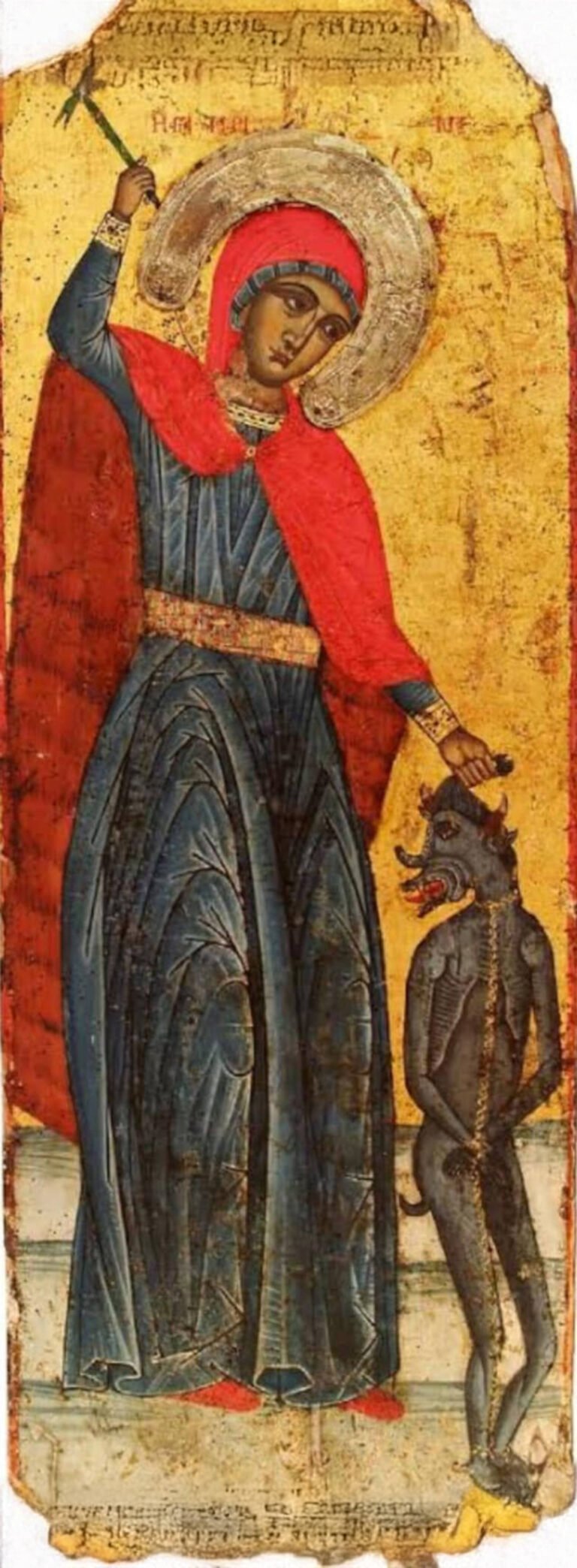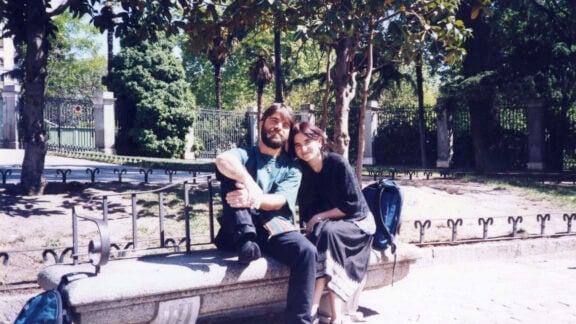Saint Marina of Antioch in Pisidia, like many women canonised in the Christian tradition, offers a compelling yet theologically intricate narrative of sanctity forged through suffering. Her hagiography, marked by trials within the domestic sphere and culminating in spiritual victory, echoes the narrative arc of countless female saints in Orthodox martyrology. Within that tradition, women are frequently portrayed as enduring unimaginable pain with quiet fortitude, their suffering elevated to a divine witness of Christ. Yet while such depictions intend to honour, they often risk subsuming female agency under the ideal of passive obedience. A reading of Saint Marina’s life informed by feminist theory does not diminish her sanctity; rather, it deepens our understanding of how holiness is framed within cultural and theological matrices that can both affirm and constrain.
The Orthodox Church venerates a great cloud of female martyrs, Saints Agathi, Paraskevi, Catherine, and Thekla being but a few examples, whose witness is marked not only by physical suffering but by an unwavering commitment to spiritual truth, often in defiance of patriarchal authority. These women are lauded for their chastity, their silence, and their resistance to forced marriage or sexual domination, virtues valourised within a theological framework but also deeply gendered in their expression. In this context, Saint Marina’s life assumes its place within a tradition that, while exalting women, frequently links their holiness to their capacity to suffer virtuously within structures that deny them power.
According to tradition, Saint Marina was disowned by her pagan priest father after revealing her Christian faith and was later subjected to violent persecution by Olybrius, the Roman governor who demanded her submission. Olybrius’ violence was not merely personal but systemic, expressing the imperial logic that demands conformity from all, especially women whose bodies and wills must be governed. Far from being a mere antagonist, he becomes emblematic of the coercive machinery of state patriarchy, a juridical and ideological apparatus enforcing submission through fear, shame, and the erasure of spiritual identity. His role mirrors the broader structures of domination that Orthodox theology critiques in its understanding of fallen human authority. Feminist theorist Silvia Federici has demonstrated how the family and the state both function as sites for the disciplining of female bodies and the reproduction of social hierarchies. The seemingly institutional context of Marina’s ordeal thus reflects, in Orthodox terms, the disordered cosmos, a world in which the imago Dei is obscured by the will to control and possess. Sara Ahmed’s concept of affective economies is also relevant here, clarifying how institutional power generates and channels emotion to maintain its grip. In Orthodox language, such impulses are understood as passions, disordered desires that enslave and deform the person. Against this, Marina’s composure and refusal constitute a radical spiritual autonomy, an ascetic unmasking of false power, and a refusal to concede the truth of her being.
Here, Michel Foucault’s insights into disciplinary power offer additional depth. Olybrius functions not only as an instrument of coercion but also as a regulator of the body, attempting to produce a subject who conforms to imperial expectations. Marina’s resistance can thus be viewed as a disruption of what Foucault deems “biopower,” a refusal to allow her body and belief to be managed by systems of surveillance and control. Her torture is not merely punitive but disciplinary, seeking to inscribe docility upon her flesh. Yet her refusal renders her body an ungovernable space, one that transcends the logic of imperial control and asserts the primacy of the soul.

This refusal also invites reflection through the lens of Luce Irigaray’s theory of the symbolic feminine. Irigaray critiques the way Western metaphysics has historically constructed woman as the mute mirror of man, existing only as a reflection of male desire or theological projection. In such symbolic economies, the female saint is often the vessel of virtues defined externally—chastity, silence, endurance—while her own voice and symbolic richness are suppressed. Saint Marina disrupts this dynamic by reclaiming her suffering body as a site of divine agency. Her actions refuse containment within a phallic logic of meaning, and instead open space for a theological poetics where the feminine is not the passive recipient of grace but the active icon of its mystery. In this light, Marina becomes not merely a spiritual symbol, but an eruption of the Real into a patriarchal symbolic order that cannot fully account for her.
To engage Saint Marina’s life through a feminist theological lens is not to desacralise it. It is instead to reframe sanctity as an active, even resistant, posture. Orthodox theology understands martyrdom more as a witness (μαρτυρία) to truth than a celebration of pain. However, the aesthetics of hagiography can often blur this distinction, especially in the case of women. Elisabeth Schüssler Fiorenza’s notion of kyriarchy, a system of overlapping oppressions, speaks to how Christian discourse can idealise female suffering in ways that reinforce submission. Within Orthodox iconography and hymnography, female martyrs are often shown serene, silent, composed, symbols of triumph over the passions, but also, at times, symbols of femininity framed through male expectation. The challenge is to read through these representations, not against them, to recover the depth of the spiritual struggle they veil.
Saint Marina’s silence, interpreted historically as humility and endurance, recalls similar traits ascribed to other female martyrs in Orthodox liturgical texts. Yet, as Audre Lorde reminds us, silence is often a strategic response to structures that disallow women full speech. Judith Butler’s concept of normative performativity also illuminates how religious femininity is reproduced through the repetition of docility. Orthodox theology, however, offers resources for resisting such flattening. The Fathers of the Philokalia, for instance, speak not of docility but of nepsis, or watchfulness, as the essence of ascetic discipline. Saint Marina’s silence may thus be reinterpreted not as mute submission, but as neptic resistance, a spiritual act of self-possession amid assault.
Orthodox martyrology is deeply invested in the idea that suffering, when united to Christ, becomes redemptive. Yet it also warns against mistaking suffering itself for sanctity. Saint Maximus the Confessor insists that virtue lies not in the endurance of pain but in the alignment of the soul with divine love. When viewed this way, Saint Marina’s perseverance reveals not a glorification of abuse, but a refusal to allow suffering to define her. Her inner life, marked by prayer, self-restraint, and resolve, becomes, as Walter Mignolo posits, an act of epistemic disobedience, a reclaiming of spiritual agency within a system that sought her erasure. Her story, like that of so many female saints, shows how holiness can be lived under such erasure, yet never extinguished.
Orthodox theology has long honoured women saints as bearers of divine light. Yet it has also idealised a particular image of female sanctity, virginal, modest, obedient, and long suffering. This typology, while spiritually profound, can become reductive if not critically examined. A feminist hagiography would not abandon these categories, but would interrogate how they are used. What does it mean, for instance, to call Saint Marina pure, when her purity was forged through relentless suffering? What does it mean to call her humble, if humility becomes indistinguishable from voicelessness? These questions do not dismantle Orthodox theology; they refine it, pressing it to make visible the moral and spiritual dimensions of power.
Crucially, Saint Marina is not only a passive sufferer. The iconic moment in her hagiography, her beating of the devil, upends the image of female saint as mere victim. Within Orthodox tradition, this episode is understood as a triumph of spiritual authority, a proof of divine grace operative in the weak made strong. The depiction of Marina lashing the demon in her prison cell stands as a striking counter narrative to the litany of silent martyrs. She is not only preserved from corruption; she becomes its destroyer. Within a feminist framework, this image assumes revolutionary significance, the abused girl becoming exorcist, the voiceless becoming judge. In Orthodox eschatology, the saints are said to judge the world. In that sense, Marina’s action prefigures a moment when truth confronts deception and justice is made manifest.
Rather than venerating her pain in abstraction, we might celebrate Saint Marina’s spiritual defiance. Like Saint Barbara, who challenged paternal tyranny, or Saint Catherine, who refuted the philosophers, Marina emerges as a counter patriarchal witness. Her sanctity is not the absence of protest, but its sublimation into spiritual clarity. For Orthodox theology, which understands salvation as the restoration of personhood in the image and likeness of God, this reading is not alien. On the contrary, it fulfils the Gospel’s proclamation, to set the captives free and bind the broken hearted. Saint Marina’s sanctity lies in her refusal to become what her abusers desired, a cipher of shame. Instead, she becomes a sign of transfigured being, a living icon of divine resistance.
In the Orthodox liturgical calendar, Saint Marina is remembered among the great virgin martyrs, yet her story is not always considered with the theological depth it deserves. Too often, it becomes a sentimental moral tale, useful for inculcating piety, but shorn of its ethical weight. A critical theological engagement would read her life as a parable of unjust suffering overcome, not endured for its own sake. In doing so, Orthodoxy honours not only Marina’s sanctity, but also her struggle, and in turn, affirms the ongoing struggle of those, especially women, whose pain remains sanctified but unspoken.
Saint Marina thus occupies a liminal space in the Christian imagination, holy, yet neglected; venerated, yet misread. Reclaiming her story through the dual lenses of Orthodox theology and feminist critique allows for a more faithful accounting of her life. It invites us to see in her not only a model of virtue, but a companion in resistance, as a saint who, though canonised in silence, now speaks with a voice forged in fire. Her memory calls not merely for endurance, but for transformation. And in that call, we find the truest promise of Orthodox theology, not to baptise injustice, but instead, to redeem the world.









